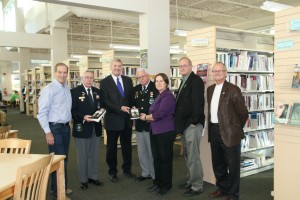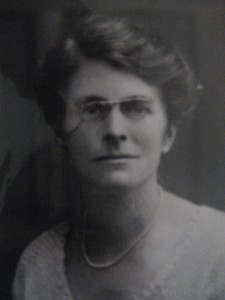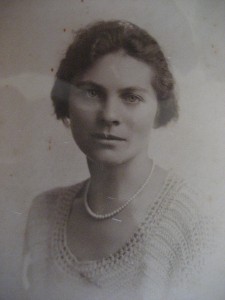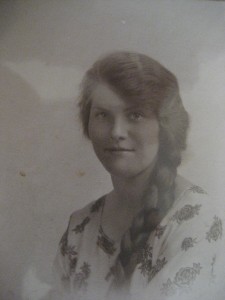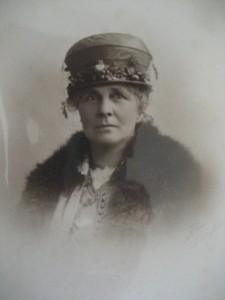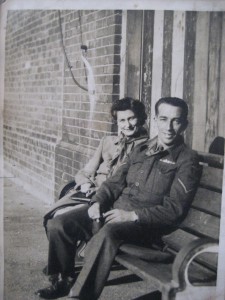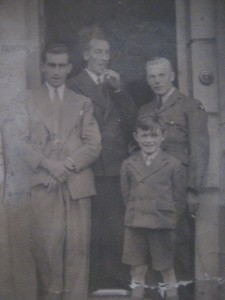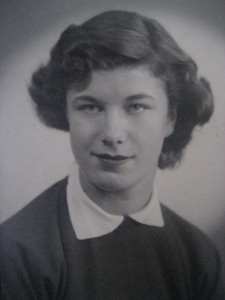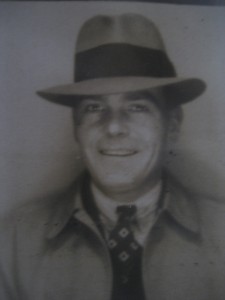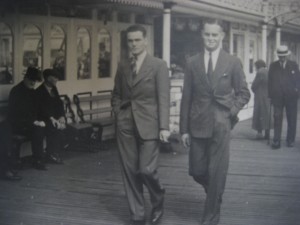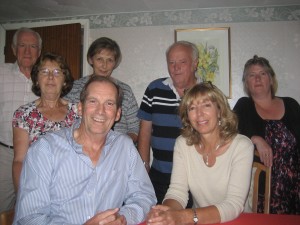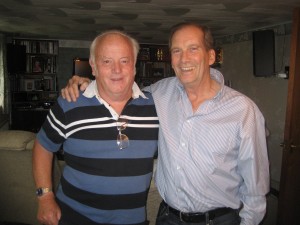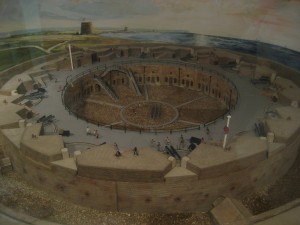Search
Gervais-Laekas Services
World War II, Les Fusiliers Mont-Royal, Dieppe
The Journey’s End
On Tuesday 20 November 2012, we sit in the lobby of our hotel in Dieppe New Brunswick waiting to meet Paul Belliveau the Councillor for Ward #3 in the city of Dieppe, New Brunswick. While in Dieppe France in August 2012, we met Paul at one of the receptions commemorating the Dieppe Raid and decided to take him up on his invitation to visit his home town. Prior to our visit to New Brunswick I had offered a copy of “A Soldier’s Journey (1940-1945)” for whatever Association or Institution Paul believed was appropriate.
A car pulls up to the hotel and Johanne and I recognise our host Paul. He greets us warmly and we are off. Paul explains the agenda for the day and minutes later we arrive at City Hall. We enter the lobby where a small reception committee awaits us that includes the city’s Mayor Yvon Lapierre, Dieppe’s Veterans’ Association members Nils Lijemark & Art Cuthbertsome, and local Historian Ron Cormier. After introductions, we go to the Public Library and meet the Library Director, Nathalie Brun. His honour the Mayor takes me on a short tour of the impressive library while Johanne chats with the others in the group. A photographer, Diane Porlier, joins us and it is time for the donation. The process calls for me to present my books to Nils and Art who will then donate them to Nathalie for the Dieppe Library.
After the presentation, Art asks me to autograph the books. What a thrill for me! Nathalie receives the books and thanks me, as does the Mayor and Art and Nils. I am amazed and so blown away by their sincere appreciation for what I thought was just a simple act. I just gave them 2 books but they gave me so much more. Mindful of his schedule, Paul brings the event to a close and the Mayor and Nathalie leave us. We go outside to see Dieppe’s very unique cenotaph.
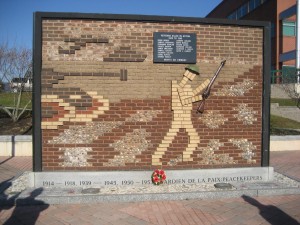 It is made with les gallets (pebbles) from the beach in Dieppe France where the Canadians fought and died. Bricks form the rough outline of a soldier, tank, plane and ship while the stones from the beach signify the location where the various regiments landed and how many men died (913). A poignant reminder of another Dieppe.
It is made with les gallets (pebbles) from the beach in Dieppe France where the Canadians fought and died. Bricks form the rough outline of a soldier, tank, plane and ship while the stones from the beach signify the location where the various regiments landed and how many men died (913). A poignant reminder of another Dieppe.
We say goodbye to Nils, Art, Ron and Paul leads us back inside and gives us a tour of the City Hall’s social centre’s facilities available to artists and citizens. Quite exceptional. The City Council Chambers are first rate. Paul takes us to the 3rd floor for a view of Dieppe from one of the city manager’s offices. As we are leaving, the Mayor calls from his office and chides Paul for not having me sign the city’s visitor book. I go in and the Mayor describes how he negotiated to have Queen Elizabeth and Prince Philip visit Dieppe in 2002. He shows me where they signed the visitor’s book.
He flips to a new page for me. WOW!
Paul takes us to lunch at a local Creperie and then we are off for a tour of Dieppe by car. I can’t say enough about this city that to us was just a name on a highway sign as we sped past on trips to and from Nova Scotia. It has something for everyone but is not resting on its laurels. The plans for development would make most cities envious.
Drawn by his conscience, Paul feels the need to takes us to Moncton for a brief tour of their rival sister city. It seemed like a much older sister with a less dynamic air about it.
To finish the day, Paul takes us to 2 golf courses, Fox Creek and Royal Oaks. From what we saw, these are going to be a reason to stop on our way to Nova Scotia. Wish I had taken photos.
We arrive back at the hotel and bid Paul a fond farewell. He has been a most gracious host. Before we part, I tell him that today’s events, though unplanned, mark for us the journey’s end of our much-loved book project.
How fitting that what started because of Dieppe France ends in Dieppe New Brunswick.
03 September – Blog Postscript
No problem getting to Gatwick – Google directions took us right to the rental car agency without a hitch. At the airport check-in the girl weighs our carry-on. They didn’t do that when we left Canada. Just as well. Both my PC bag and backpack were and are still overweight. I knew they were when we left Canada. Johanne’s bag is overweight too. I take the computer out and send the PC bag as checked luggage. Johanne must check her bag as well. Strange but they let me keep my overweight backpack as carry on. Next we go through security. Johanne transfers the contents of her plastic baggie full of lotions to the bags supplied by the airport. The contents fit easily. She picks up a few more Gatwick plastic bags and tosses them into her bin. The security guard inspects her bin contents and removes the excess plastic bags. “I wanted to use them on future flights when we travel with the family,” she says. “You only need 1 to board your flight. If I let you and others take extras, we’d go broke now, wouldn’t we?” Johanne is at a loss for words and I suggest we continue through security. The security agent on the other side of the people scanner is gesturing in my direction and indicating the shoes should come off. I begin to remove my shoes but she shakes her head. “Not you,” and points to Johanne behind me. “Lady, please remove your sandals and put them in the bin.” The system at Gatwick seems to be out to spoil Johanne’s journey home. Especially since I’m now trying to stuff my PC into her shoulder bag. As I’m doing so, she laments, “Why is your hairbrush, the mousepad, your razor, and other “stuff” in my shoulder bag?? No wonder nothing fits!” My solution is to find a place to sit, give her all my remaining English pounds, and let her shop. It must be working because she’s been gone for over an hour. We board and take off on time. We get a lunch and see two terrible movies, The Three Stooges and Hoot. We finally arrive at Dorval and experience the new process for clearing customs – passport & declaration kiosk scanners. It sure beats the usual long and winding line-ups. We pick up our overweight luggage from the carousel and head to Avis for our car. I have a choice of a Dodge 300 or a little Fiat. Which one do you think I took? Johanne keeps me on the right-hand side of the road and we make it home in record time – its 4:00 pm with no traffic! Coming back on a holiday is a brilliant idea. Home sweet home!
2 September – End of blog
We have completed all that we set out to do with the exception of finding the gravesite of my grandfather Charles Tilden Baker. My task today is to keep Johanne occupied without keeping me too occupied. There’s a fine mist outside – a perfect day to do some grave searching. We walk to the Forest Row cemetery to see if we can find my grandfather’s gravesite. It’s a bit of a long shot since he lived in Forest Row for only a few years before he moved to Brighton, but we’re determined to check out all possibilities. Johanne goes off down the rows, searching for a stone with his name. 
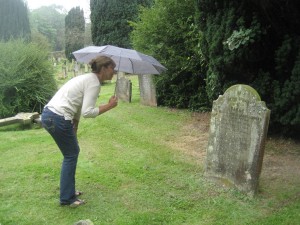 We find a few Bakers, but not Charles. He’s definitely somewhere else. We decide to go for a hike in the Ashdown Forest, not to look for my grandfather, but to check out the view of the South Downs. The search for my grandfather will have to continue when we get home in St. Bruno. On the way to the South Downs hiking area, we have to share the road with the locals.
We find a few Bakers, but not Charles. He’s definitely somewhere else. We decide to go for a hike in the Ashdown Forest, not to look for my grandfather, but to check out the view of the South Downs. The search for my grandfather will have to continue when we get home in St. Bruno. On the way to the South Downs hiking area, we have to share the road with the locals. 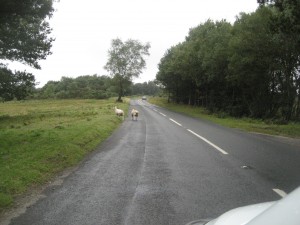 The sheep and cattle graze freely and appear to have the right of way.
The sheep and cattle graze freely and appear to have the right of way. 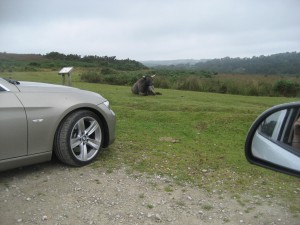 The view from this area of the South Downs on the edge of the forest is stunning.
The view from this area of the South Downs on the edge of the forest is stunning. 
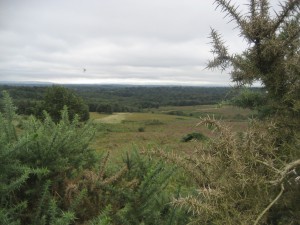 Always the fashion diva, Johanne’s “hiking” sandals are all the rage. Everyone else is wearing Wellingtons. Notice how the colour of her footwear blends with the natural surroundings.
Always the fashion diva, Johanne’s “hiking” sandals are all the rage. Everyone else is wearing Wellingtons. Notice how the colour of her footwear blends with the natural surroundings.  We walk towards a distant stone enclosure. It’s a memorial to the crew of a Wellington Bomber that crashed at this site on 31 July 1942. They were either on their way out or coming home and something brought them down. The serial number of the Wellington is W5364 so we should be able to find what happened to it. Perhaps when I get back.
We walk towards a distant stone enclosure. It’s a memorial to the crew of a Wellington Bomber that crashed at this site on 31 July 1942. They were either on their way out or coming home and something brought them down. The serial number of the Wellington is W5364 so we should be able to find what happened to it. Perhaps when I get back.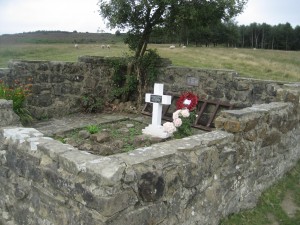 After a couple of hours of walking, Johanne’s sandals are filthy, covered with grass and whatever. It’s time to go. We arrive back at the Chequers looking forward to the Sunday afternoon Carvery. The hiking has worked up an appetite. But first we must make ourselves presentable. I get the most difficult job, cleaning her sandals. For our meal, we have the choice of lamb, beef, turkey or any combination. I have roast beef and Johanne chooses the turkey.
After a couple of hours of walking, Johanne’s sandals are filthy, covered with grass and whatever. It’s time to go. We arrive back at the Chequers looking forward to the Sunday afternoon Carvery. The hiking has worked up an appetite. But first we must make ourselves presentable. I get the most difficult job, cleaning her sandals. For our meal, we have the choice of lamb, beef, turkey or any combination. I have roast beef and Johanne chooses the turkey. 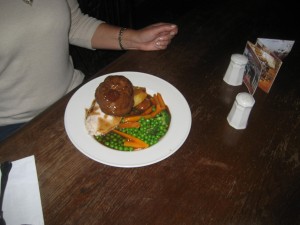
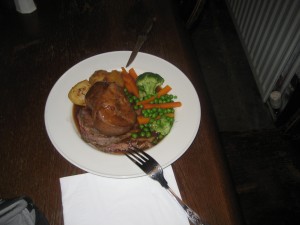 After a delicious meal, we retire to our room to pack. Johanne is concerned it might not all fit – its the books and magazines on the Dieppe 70th Anniversary that are causing her grief.
After a delicious meal, we retire to our room to pack. Johanne is concerned it might not all fit – its the books and magazines on the Dieppe 70th Anniversary that are causing her grief.
It has been a remarkable and at times emotional 18 days. We have enjoyed providing a glimpse of our adventure to all who have followed our blog. I look forward to sharing the memories of this trip when we get home with my family, siblings, and friends.
Until our next adventure.
Michael
1 September – Winding down
My cousin Robin asked for another get together before we leave to go home. I call him and offer to buy him a pint if he comes to the Chequers. He and Jean will join us at 8:00pm. After a late breakfast, we go to East Grinstead to check the train schedule for London Sunday. The trains go every hour. Johanne thought a walking tour of London might be nice but the available walking tours leave from various different tube stations, depending on the type of walk you want. Not sure we want to be running looking for tube stations in London on our last day here and it wasn’t obvious from the schedule what tours were available on a Sunday. Bus tours of London are another option. The earliest tour we could make leaves at 2:00pm but by the time we would get back to Forest Row, it would be late in the day. As we need to pack up Sunday night to be ready for an early departure Monday morning, we decide against the trip to London. Johanne noticed that today there’s a market fair in Forest Row. By now it’s late afternoon. Off we go for a walk. Just our luck. They’re closing up when we arrive. We decide to keep on walking around Forest Row for some much needed exercise. We get back to the Chequers, have a nice meal and before we knew it, Robin and Jean arrive. We share with them the details of our visit with Joan the day before. Robin showed Johanne a magazine (Your.FamilyTree) which included an article on searching for gravesites. He suggested looking for Charles T. Baker at the Forest Row Cemetery and failing that, to contact the Records Office in Chichester (West Sussex records office) since Haywards Heath where we think my grandfather is buried is on the East/West Sussex boundary. Oh great! Another 2 hour journey. The discussion carries on until Robin looks at his watch. It’s past 11pm and we suspect Claudio is anxious to close up. Robin produces his copies of “Mary and John, The Early Years” for me to sign. What an honour for me! This is the first time I’ve been asked to autograph my books. The evening with Robin and Jean was a really nice end to what had been a directionless day. We say our goodbyes and allow Claudio to lock up. Before we retire for the night, Johanne says, “So what are we going to do tomorrow?”.
31 August – My mother’s eyes
Today we are off to visit my mother’s close cousin Joan Williams (nee Walder) in Bournemouth. The two young girls lived near one another in Chelwood Gate and later, when my mother moved to Brighton, they visited each other. In 1940, my grandmother sent my mother away from Brighton to stay with her sister Gertie in Chelwood Gate (they ran a bakery). One reason was the raids on Brighton by German bombers. The second was a matter of the heart. My mother’s first true love, Flying Officer Thomas McGuillian Parker, died in combat leaving my mother in a state of depression. My grandmother believed time with her cousin Joan would help her mend. Two days ago, I telephoned Joan and she is eager to see us.
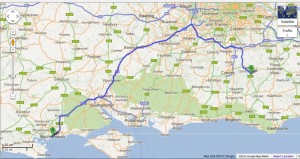
We leave Forest Row a little later than we plan but hope to make up time on the road. Google directions indicate it is a 2hrs 22 minutes journey. No problem getting to the M25 and we are sailing along for 30 minutes when flashing signs warn us of congestion ahead. Sure enough, we end up doing 20 mph on the expressway for a bit and then we speed up again. There’s no sign of accident, breakdown or any other event that might cause traffic to slow. We reach the turnoff for the M3, which also includes signs for Kew Gardens in the opposite direction. Had we known, we could have avoided the aggravation of our cross-country expedition to the National Archives in Kew. I expect traffic to be light in that we are heading away from London. Johanne notices many cars packed with suitcases, pillows, and other going-away gear. “Of course,” she says. “This is the last weekend before people on vacation go back to school and work. They’re all headed for the coast.” Our voyage southwards or as the highway signs indicate to “The West” is a combination of high-speed dashes and turtle-like crawls. Finally, we see signs for Bournemouth, but there are also signs for the weekend Bournemouth Air Show that we later learn will include the Red Arrows and the last airworthy Vulcan Bomber. There is also some sort of boat show. We’ve hit the jackpot! A bloody holiday weekend and two damn shows in the same area.
Eventually we get to Bournemouth and, with the help of a pedestrian, we find our way to Joan’s place. It’s on a quiet street with plenty of places to park. Johanne is fretting. We’re 1 hour later than expected. We ring the bell and Joan appears at the end of the hallway to greet us. As I approach her, I see my mother’s eyes. She hugs me and I hold her for a long time, caught up in the moment. She invites us in to her beautiful, bright, and very well appointed flat. She’s not all bothered that we’re late. The table is set in the dining room.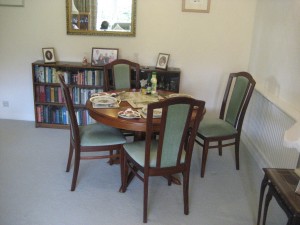 As we talk, Joan serves a delicious lunch that includes various meat and vegetarian dishes. Afterwards she brings out a photo album and we spend the afternoon, looking at the remarkable photos from our past and talking about the family.
As we talk, Joan serves a delicious lunch that includes various meat and vegetarian dishes. Afterwards she brings out a photo album and we spend the afternoon, looking at the remarkable photos from our past and talking about the family.
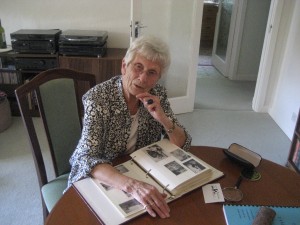
Joan is a wealth of information. She confirms the photo we assumed was Frank Harper isn’t Frank. She tells us my great grandfather Walter Pinker died in 1943 of a heart attack in Lewes while he contested a town order to convert his strawberry fields into potato patches for the war effort. He died on the steps of the town council. She also provided information on the Pinker family and her own family for Johanne to add to our family tree. 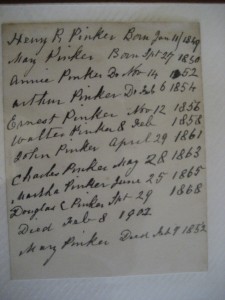
After too short a visit, we bid Joan a fond goodbye. 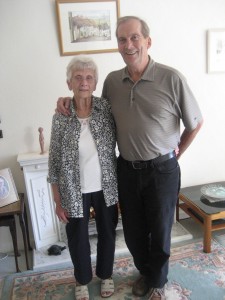 Though the drive home is less aggravating (we do encounter congestion in a few areas), it’s been a long day and we’re pleased when we pull in to Forest Row just after 8:00pm. We close the day with two pizzas, wine, and a recollection of our delightful time with a wonderful person.
Though the drive home is less aggravating (we do encounter congestion in a few areas), it’s been a long day and we’re pleased when we pull in to Forest Row just after 8:00pm. We close the day with two pizzas, wine, and a recollection of our delightful time with a wonderful person.
30 August – Searching for Charles Tilden Baker – my grandfather
After breakfast, Johanne does a bit of shopping for some toiletries while I take my time getting ready to go out. Though our destination today is Lewes and the Records Office, on the way we’ll be stopping at Chelwood Gate. Last year, we visited the house where my mother was born and lived. Maureen Noble, the current owner of Whyteleaf Cottage, allowed us to tour her house. During the winter, Johanne did some digging with the help of the East Sussex Records Office and found some interesting information regarding the history of Whyteleaf. We plan to go by Maureen’s house and drop off the information. In case Maureen is out, I write her a note that I attach to the documents. Johanne comes back and off we go. It’s a short drive to Chelwood Gate and Maureen’s house on Stone Quarry Road. I knock on the door and her daughter answers. Maureen is away until next week. I explain why I’m there, chit chat for a bit and leave the envelope. Now to Lewes where, during the war, Canadian soldiers lived, loved and laughed while waiting to be sent off to war. Lewes is a beautiful town nestled in the South Downs. Just before noon we arrive downtown with not a vacant parking spot in sight. I manage to find one in a short-term lot and we start walking to the Records Office which is near the Lewes Castle, bypassed earlier in the week in favour of Eastbourne. On the way, I take a few photos of the Castle while Johanne marches on looking for the Office. 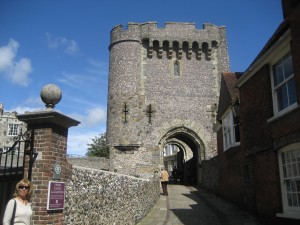

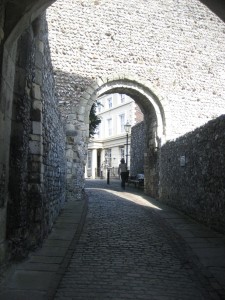 We walk past the site of the former Castle Tilting Ground (for jousting) that was converted to a Bowling Green in 1640.
We walk past the site of the former Castle Tilting Ground (for jousting) that was converted to a Bowling Green in 1640. 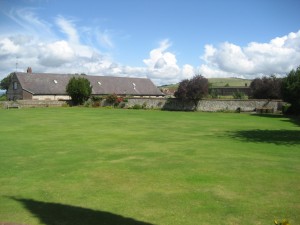 The Records Office is located on the opposite side of the Green.
The Records Office is located on the opposite side of the Green. 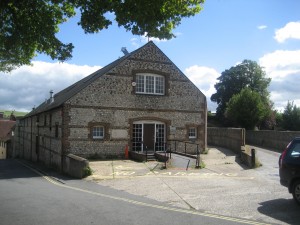 They don’t have the computer-based interactive entrance exam, but they do require we put most of our stuff in a locker. We go to the reading room and Johanne explains what we’re seeking. The clerk’s initial response is that the information we want will be in the West Sussex Records Office. Johanne isn’t settling for this. She feeds him more facts, and Drew (presumably the Andrew who Johanne corresponded with for the Whyteleaf information) thought he might be able to help. A bit more digging turns up nothing. “Your Grandfather would most likely have been buried in Brighton because that’s where he lived before he died. You should check with the cemetery in Brighton.” “We did last year,” Johanne tells him, “and we spent hours going through their records.” “Well, considering he passed away in Haywards Heath St Francis Hospital, you should contact the cemetery there.” “We did last year and they have no record of a Charles Tilden Baker,” she responds. It’s clear we’ve come to a dead end.
They don’t have the computer-based interactive entrance exam, but they do require we put most of our stuff in a locker. We go to the reading room and Johanne explains what we’re seeking. The clerk’s initial response is that the information we want will be in the West Sussex Records Office. Johanne isn’t settling for this. She feeds him more facts, and Drew (presumably the Andrew who Johanne corresponded with for the Whyteleaf information) thought he might be able to help. A bit more digging turns up nothing. “Your Grandfather would most likely have been buried in Brighton because that’s where he lived before he died. You should check with the cemetery in Brighton.” “We did last year,” Johanne tells him, “and we spent hours going through their records.” “Well, considering he passed away in Haywards Heath St Francis Hospital, you should contact the cemetery there.” “We did last year and they have no record of a Charles Tilden Baker,” she responds. It’s clear we’ve come to a dead end.  We thank Drew and take our leave. “What do we do now?” Johanne asks discouraged. When in doubt, suggest a restaurant. I do and we find a nice Italian restaurant on High Street. Over lunch and a couple of glasses of wine we discuss our options. No point in returning to Brighton, because we conducted an exhaustive search of their records last year. In addition to the negative search by Haywards Heath Cemetery Authorities to Johanne’s query last year, Viv & Brian were also unable to find Charles Tilden Baker in their search of the cemetery. I suggest we look once more in the Danehill cemetery near Chelwood Gate. We didn’t find him last year when we looked but as it is on our way home to Forest Row, why not. A short while later, we’re there. I take one side of the cemetery and Johanne the other. We find other Bakers who no doubt are on Robin’s Family Tree, but no Charles Tilden. Before we leave, I say hello to my Great Grandmother, Mary Pinker. Remarkably, her stone remains in excellent condition unlike most others on the grounds.
We thank Drew and take our leave. “What do we do now?” Johanne asks discouraged. When in doubt, suggest a restaurant. I do and we find a nice Italian restaurant on High Street. Over lunch and a couple of glasses of wine we discuss our options. No point in returning to Brighton, because we conducted an exhaustive search of their records last year. In addition to the negative search by Haywards Heath Cemetery Authorities to Johanne’s query last year, Viv & Brian were also unable to find Charles Tilden Baker in their search of the cemetery. I suggest we look once more in the Danehill cemetery near Chelwood Gate. We didn’t find him last year when we looked but as it is on our way home to Forest Row, why not. A short while later, we’re there. I take one side of the cemetery and Johanne the other. We find other Bakers who no doubt are on Robin’s Family Tree, but no Charles Tilden. Before we leave, I say hello to my Great Grandmother, Mary Pinker. Remarkably, her stone remains in excellent condition unlike most others on the grounds. 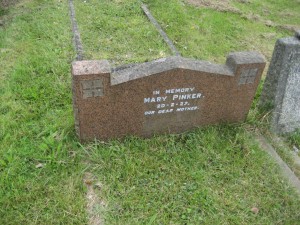
We return to the Chequers and go for supper. The temperature outdoors is 15C and that puts Johanne in the mood for a Steak & Ale Pie. I have Harvey’s beer battered fish & chips. For now, we put our search for my grandfather’s gravesite on hold. Tomorrow we’ll be heading for Bournemouth, a 2 ½ hour drive to the west coast to visit with my mother’s cousin Joan. Hopefully, we’ll find our way!
29 August – Vivienne and Brian Simmonds
Today we’re off to visit my cousin Vivienne and her husband Brian. We leave Forest Row for a comfortable drive to Goring-by-Sea near Worthing. Having been this way when we went to Portslade, the initial part of the journey is simple, except I miss a turn at a tricky double roundabout near Lewes and have to double back. It’s a beautiful sunny morning, a deep blue sky with some white clouds chased by a strong breeze. As we pass Shoreham, from the A27 we have a spectacular view of the majestic Lancing College. It was at this school on 18 August 1942 that my father and the rest of Les Fusiliers Mont-Royal Regiment ate their last meal before descending to the beach at Shoreham and embarking for the landing at Dieppe the next morning. We follow Google directions and they bring us to Marine Parade, a road in Worthing that runs beside the sea. Johanne says that at some point we have to turn left. I don’t think so. The channel is on our left and the only place to turn in that direction appears to be a pier off in the distance. We begin to doubt our Google directions, considering some of the difficulty it’s given us. In spite of our reservations, Google takes us to South Avenue, a quiet, little street where my cousin Vivienne and her husband Brian live. Only one problem. Johanne can’t find the address. Not to worry. I can see Viv standing at the end of her driveway waiting our arrival. Silly us. We have the address. It’s September Cottage. There are no street numbers!
We receive a warm welcome from Brian & Viv. Once settled, they’re interested in our visit with Robin Wood. Johanne shows them the remarkable Baker Family Tree that Robin and his daughter Sandra created. They’re fascinated by the detail it provides, including information concerning their family, though I must correct an oversight (perhaps on our tree) when I next contact Robin. Viv isn’t listed in the publication! We spend much time talking about the Baker clan, particularly the colourful characters. We tell them about our other exploits since coming to Europe. After a delightful lunch, we’re back to discussions about the family. Viv & Brian bring out old photos. What amazing treasures.
I show Viv a photo I took at Robin’s of someone we believe to be Frank Harper, her mother’s first husband and the father of her sister Jenny and brother John. She has no recollection of him other than she was was told he looked like a famous actor.
According to Rodney Mitchell (see 27 Aug blog), his father Norman and Frank were great friends. Based on this information, we conclude the mystery man must be Frank Harper. If anyone following our blog can confirm or refute our assumption, please do in a comment.
After much more entertaining banter, the wonderful, relaxing day with distant but loved family members unfortunately comes to an end. We pose for several takes of a group photo before I can get the flash working.
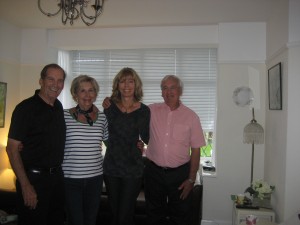 Brian has the same problem with his camera. Perhaps it’s a guy thing. We say goodbye and I promise to return soon.
Brian has the same problem with his camera. Perhaps it’s a guy thing. We say goodbye and I promise to return soon.The weather for the drive from Forest Row to Viv & Brian was excellent. However, while we were indoors enjoying our visit, things changed. The sky is a depressing grey and a cold driving wind blows in off the sea. The rain is chilling and we rush to get into our car. Definitely a bad hair day for Johanne & Viv.
The drive back is uneventful and I breeze through the tricky double roundabout with ease. Back at the Chequers, we sit by the bar, enjoy a light supper (fried calamari and greens / duck pate with chutney), a glass of Pinot Grigio and Johanne begins to download the POW list we received yesterday from the National Archives email link (120 individual files). If we don’t download our hard earned work, they disappear from the National Archives link after 7 days.
Tomorrow we’re going to the East Sussex Records Office in Lewes to try and find my grandfather Charles Tilden Baker’s gravesite.
Last year when we were in England we did an extensive search of Brighton, Haywards Heath, and Danehill cemeteries in East Sussex without any luck. Hopefully the Records Office will shed some light on the whereabouts of my elusive Grandfather.
28 August – Keeping a promise
When in Poland last year, we promised Mr. Piotr Tarnawski (historian at the Stargard museum) and Mr. Piotr Stanek (historian at The Central War Museum in Poland) that we would try to get them a list of Canadian POWs incarcerated during the Second World War in Stalags 2D & 8B. Those are the 2 Stalags that my dad was in for over 2 years. From Johanne’s research, she learned that this information is available at The National Archives in Kew. Before we left for Europe, I downloaded from The National Archives site a complete list of British Army POWs but the information for Commonwealth POWs was only accessible at The Archives. Last Saturday, we failed to get the information, thanks to a Bank Holiday weekend which closed the Archives for 3 days. Today is our 2nd attempt and there aren’t many more opportunities before we fly back.
Now that I’ve had a glass of wine at the Chequers, allow me to share today’s experience with you. We leave by 10:00 am for the 1 hour and ten minute drive to Kew and the site of The National Archives. Having travelled the route already, we’re confident we can find the way, or should I say overconfident. We glance at the Google directions which have us taking the M25 towards London, but it’s the large signs indicating direction for M25 that have our attention. At the roundabout to join the M25, we follow the signs and exit at the 2nd spoke. Johanne looks at the Google directions, which tells us to exit at the 4th spoke. We’re on the M25 towards London but heading east instead of west. “Not to worry,” I say. “We’ll just take the first exit, turn around, and go the other way.” We drive for at least 30 minutes with no sign of an approaching exit. On the westbound side of the M25 (where we want to go), we see an overturned car off on the side of the highway and the traffic approaching it has come to a halt. The traffic backlog goes for miles and we realise turning around is no longer an option. Johanne is consulting our map of England which is fine for major routes but very difficult to read for secondary roads. We’re heading towards the east side of London and we need to be on the west side. We don’t relish the idea of driving through London Centre so Johanne is looking for other routes. We take the exit for Biggin Hill and look for anything that will take us west. Johanne directs us towards Croydon which we manage to find but poor signage and confusing roundabouts leads us south to Coulsdon. After 2 ½ hours, we’re just south of the M25 near Reigate, closer to where we started in Forest Row than our intended destination of Kew. I’m ready to throw in the towel and head home. As I search for a way out of this mess, a sign appears for the M25 towards Leatherhead. Johanne convinces me to try once more. The rest of the journey is tame compared to what we’ve already done but it has taken a toll (excuse the pun) on us. I’m discouraged that we have wasted so much time that could have been better spent at the Archives. Johanne is feeling slightly car sick from having to read the map while I navigate the roundabouts. She says, “I really hope they have the information we’re looking for, because I don’t want to come back here a third time to do more research.” We arrive at The National Archives 4 hours after we started. The good news is we actually find a parking spot in the parking lot. 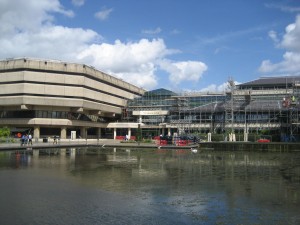 We get a bite to eat in the cafeteria before it closes then go to the information desk. After we tell her the file numbers we’re looking for, the Librarian searches on the computer and starts referring us to other documents. Johanne says pleasantly, “Thank you but We really don’t need those. I’ve already researched the files we’re looking for.” The Librarian can’t imagine why we want a list of all POWs so she continues searching for other documents but after much interruptions from Johanne finally she writes down the Library # of the files we want and she suggests a particular book in the library that might be helpful. Johanne asks if she’s sure those are the correct numbers because she’s reversed every number for each of the three files. She laughs at her silly error. Johanne is not impressed. We then go and get registered so that we can access the files. The process requires each applicant to successfully complete a computer-based interactive test in order to receive the personal reader card that provides access to the Archive’s treasures. Once we get our cards and order the files, we go for a cup of tea while we wait for them to be retrieved. Afterwards we wander over to the library section to find the book that was referred by the librarian. The book covers the subject of POWs adapting after the war and wasn’t of any use to us. Forty minutes later, the files are in Johanne’s receptacle, # 27H in the reading room.
We get a bite to eat in the cafeteria before it closes then go to the information desk. After we tell her the file numbers we’re looking for, the Librarian searches on the computer and starts referring us to other documents. Johanne says pleasantly, “Thank you but We really don’t need those. I’ve already researched the files we’re looking for.” The Librarian can’t imagine why we want a list of all POWs so she continues searching for other documents but after much interruptions from Johanne finally she writes down the Library # of the files we want and she suggests a particular book in the library that might be helpful. Johanne asks if she’s sure those are the correct numbers because she’s reversed every number for each of the three files. She laughs at her silly error. Johanne is not impressed. We then go and get registered so that we can access the files. The process requires each applicant to successfully complete a computer-based interactive test in order to receive the personal reader card that provides access to the Archive’s treasures. Once we get our cards and order the files, we go for a cup of tea while we wait for them to be retrieved. Afterwards we wander over to the library section to find the book that was referred by the librarian. The book covers the subject of POWs adapting after the war and wasn’t of any use to us. Forty minutes later, the files are in Johanne’s receptacle, # 27H in the reading room. 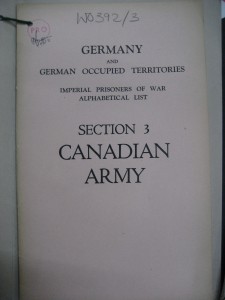
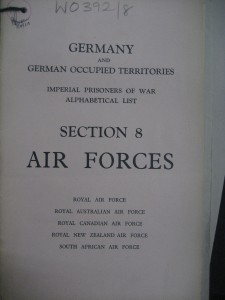
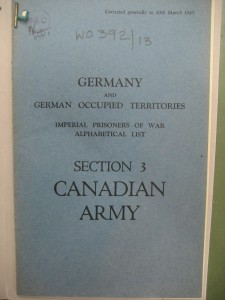 We glance at the documents and realize that we’ve hit the jackpot! Two of the files are lists of all Canadian POWs incarcerated in German POW camps! The third is a list of all Air Force POWs. This is amazing stuff. The only problem it is not sectioned by regiment or Stalag. It is an alphabetical list of names their Stalag, POW & regimental numbers, and their regiment. We split up. I take one file folder and use my camera to film each of the pages but it’s not so easy. I have to split up each page in several sections in order for the image to be readable. Johanne thinks there must be a better way and asks a fellow at the information desk if they could photocopy the pages instead. He says, “That’ll be pretty expensive. Why don’t you just use our photographic equipment for free and the images could be sent to you via email?” Away she goes and the librarian helps her focus the camera so that each full page could be captured. Fantastic. Johanne gets herself organised and her production line begins to churn out digital copies of the 119 pages of records.
We glance at the documents and realize that we’ve hit the jackpot! Two of the files are lists of all Canadian POWs incarcerated in German POW camps! The third is a list of all Air Force POWs. This is amazing stuff. The only problem it is not sectioned by regiment or Stalag. It is an alphabetical list of names their Stalag, POW & regimental numbers, and their regiment. We split up. I take one file folder and use my camera to film each of the pages but it’s not so easy. I have to split up each page in several sections in order for the image to be readable. Johanne thinks there must be a better way and asks a fellow at the information desk if they could photocopy the pages instead. He says, “That’ll be pretty expensive. Why don’t you just use our photographic equipment for free and the images could be sent to you via email?” Away she goes and the librarian helps her focus the camera so that each full page could be captured. Fantastic. Johanne gets herself organised and her production line begins to churn out digital copies of the 119 pages of records. 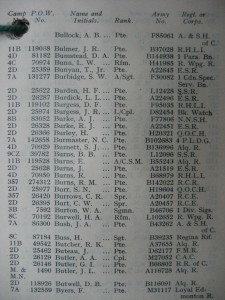
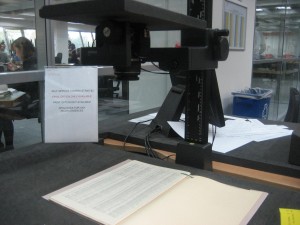
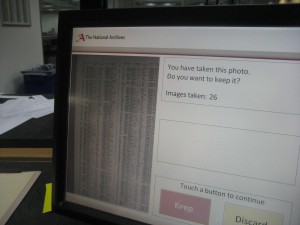 While she was busy setting up, I find my dad’s entry for Stalag 2D.
While she was busy setting up, I find my dad’s entry for Stalag 2D. 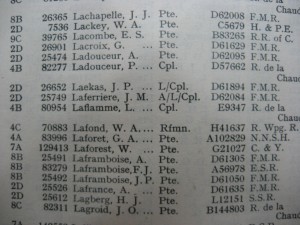 Johanne is panicking because she thinks they close at 5:00 pm and doesn’t want to come back again. She finds out they close at 7:00 pm. and by 6:00pm we’re finished – with time to spare. We now have two copies of the alphabetical list of all Canadian Army POWs held in German Stalags (my 158 pictures & Johanne’s complete page version). Also for good measure, Johanne copied the Air Force list. We’re thrilled. In spite of a very difficult beginning, we’ve achieved what we set out to do.
Johanne is panicking because she thinks they close at 5:00 pm and doesn’t want to come back again. She finds out they close at 7:00 pm. and by 6:00pm we’re finished – with time to spare. We now have two copies of the alphabetical list of all Canadian Army POWs held in German Stalags (my 158 pictures & Johanne’s complete page version). Also for good measure, Johanne copied the Air Force list. We’re thrilled. In spite of a very difficult beginning, we’ve achieved what we set out to do.
The road home isn’t as smooth as we expected with a few wrong turns along the way, but we don’t care – we’re buoyed by our accomplishment and the earlier troubles of the day soon fade away.
Tomorrow I’m looking forward to visiting my 1st cousin Vivienne (1st cousin on Baker side of family) in Worthing and sharing with her Robin & Sandra’s Baker Family Tree. Its a 1 hr drive down by the sea, away from London and in relatiively familiar territory. Piece of cake!
27 August – A day of discoveries
Today is a big day for us. Up to now, we have been dealing with inanimate objects in England, the places where my relatives lived. Today we are off to meet my 4th cousin Robin Wood. Robin and his daughter Sandra have done extensive research into the Baker family tree and we are eager to compare notes and see what further light he can shed on my link to the larger Baker family through my grandfather Charles Tilden Baker (on my mother’s side) and great-grandfather Mathias. We spend the morning doing a few odd chores, anxious to get to our mid-day rendezvous. We make our way to Tanyard Lane in Chelwood Gate and locate Robin’s house. A smiling Robin greets me at the door and welcomes us into his home. We meet his wife Jean, their daughter Sandra, her husband Shaun, and their children Ryan and Kiri. Jean explains that Robin and Sandra are the driving force behind the Baker family tree activity. I tell her that Johanne is now the expert on my family including the Baker side. Before you know it Johanne, Robin and Sandra have their documents in hand and are discussing our roots. 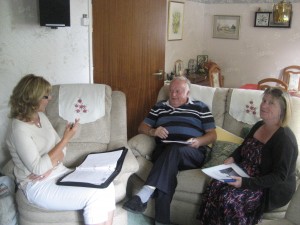 They pause for a quick photo, some delicious cupcakes served by Kiri, a cup of tea and then they dive back into the details. Robin mentions Shockbanks and Yew Tree House, two Baker ancestry residences that have evaded Johanne’s attempt to identify their location in Chelwood Gate. Johanne seizes the bait and the artful fisherman Robin toys with his catch. I sense he has something that he is not yet prepared to reveal. Robin shows us the Baker Family Tree he and Sandra created.
They pause for a quick photo, some delicious cupcakes served by Kiri, a cup of tea and then they dive back into the details. Robin mentions Shockbanks and Yew Tree House, two Baker ancestry residences that have evaded Johanne’s attempt to identify their location in Chelwood Gate. Johanne seizes the bait and the artful fisherman Robin toys with his catch. I sense he has something that he is not yet prepared to reveal. Robin shows us the Baker Family Tree he and Sandra created. 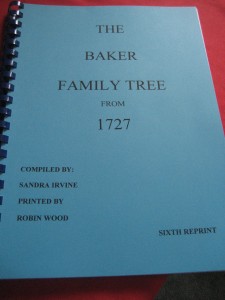 What an amazing and detailed book they’ve created! More discussion about the Baker family and Sandra tries to get her dad to share his information, but Robin isn’t quite ready. We chat some more and then Jean serves up a delicious lunch, during which the queries into the Baker family past continue. Afterwards Robin offers to take us on a short walk. Just before we go, Rodney Mitchell and his wife Shirley arrive at the Wood’s residence. Now that Robin has us where he wants us, he is too keen to stop and socialise with his latest guests. We excuse ourselves and follow Robin out the back of their house on to Stone Quarry Road. From there it is just a short walk to a large white house with a yellow door and matching shutters and a sign identifying it as Herons Brook. Robin, pleased as punch, announces it as YEW TREE HOUSE!
What an amazing and detailed book they’ve created! More discussion about the Baker family and Sandra tries to get her dad to share his information, but Robin isn’t quite ready. We chat some more and then Jean serves up a delicious lunch, during which the queries into the Baker family past continue. Afterwards Robin offers to take us on a short walk. Just before we go, Rodney Mitchell and his wife Shirley arrive at the Wood’s residence. Now that Robin has us where he wants us, he is too keen to stop and socialise with his latest guests. We excuse ourselves and follow Robin out the back of their house on to Stone Quarry Road. From there it is just a short walk to a large white house with a yellow door and matching shutters and a sign identifying it as Herons Brook. Robin, pleased as punch, announces it as YEW TREE HOUSE! 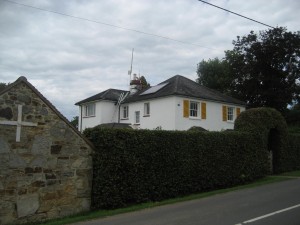
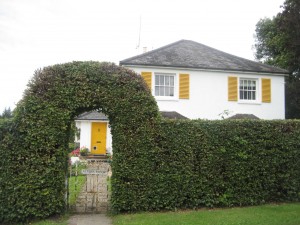 OMG. This was my great grandfather Mathias Baker’s house. We must have walked past this house a dozen times last year. This is incredible. After this little revelation, Robin takes us a short distance further to another large white house with a blue door and shutters called the Woodlands. Robin provides one more revelation when he tells us this is where Shocksbank was located, home to Joe Grinsted and my great aunt Nora. Johanne had an ordinance map of Shocksbank but neither my mother nor my Uncle Mike knew anything about it. Johanne was sure it was owned by my great-grandfather and Whyteleaf (the house my mother was born in) was on its property. Wait until I tell my Uncle Mike that Shocksbank was where the Grinsted’s butcher shop was located.
OMG. This was my great grandfather Mathias Baker’s house. We must have walked past this house a dozen times last year. This is incredible. After this little revelation, Robin takes us a short distance further to another large white house with a blue door and shutters called the Woodlands. Robin provides one more revelation when he tells us this is where Shocksbank was located, home to Joe Grinsted and my great aunt Nora. Johanne had an ordinance map of Shocksbank but neither my mother nor my Uncle Mike knew anything about it. Johanne was sure it was owned by my great-grandfather and Whyteleaf (the house my mother was born in) was on its property. Wait until I tell my Uncle Mike that Shocksbank was where the Grinsted’s butcher shop was located.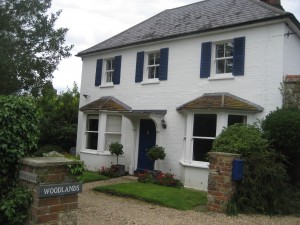
Another place we walked past last year.
We return to Yew Tree House and Robin speaks with the owner Paul who disappears into the house. I take more photos of the beautiful property. 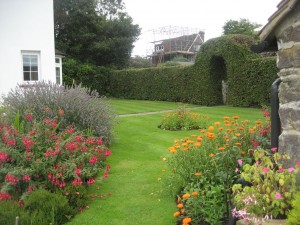
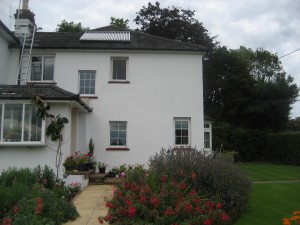
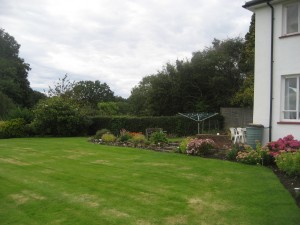
Paul returns with an armful of documents. He sorts through them and discovers the various legal documents relating to the purchase of the property by Mathias Baker (my great-grandfather), the subsequent transfer to his son Elias, my great uncle. He will send us copies of some of the documents. We return to the house and join Rodney and Shirley who have brought a bundle of documents and photos. The discussions begin anew. 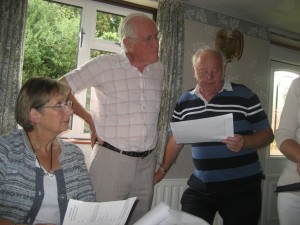 Included are some wonderful photos of various members of the family. This is like finding gold. One very interesting document is the list of pupils enrolling in Danehill School. It includes one Derek A. Pinker. In the adjacent column reserved for the name of the student’s mother or father is written Dorothy Ford. This name is lined out and just above is written Mrs. Pinker. Only certain family members know the reason for the editing of the names and I am one of them. We had a long puzzling discussion on what Rodney’s and mine relationship was in the Baker family. I later learn through MyHeritage.com that Rodney is my 2nd cousin through Gertie Pinker, his Grandmother and my great aunt. Jean serves us cream tea and we carry on. As the sun’s light begins to wane, we realise it is past 6:00pm. We have been going for over 6 hours.
Included are some wonderful photos of various members of the family. This is like finding gold. One very interesting document is the list of pupils enrolling in Danehill School. It includes one Derek A. Pinker. In the adjacent column reserved for the name of the student’s mother or father is written Dorothy Ford. This name is lined out and just above is written Mrs. Pinker. Only certain family members know the reason for the editing of the names and I am one of them. We had a long puzzling discussion on what Rodney’s and mine relationship was in the Baker family. I later learn through MyHeritage.com that Rodney is my 2nd cousin through Gertie Pinker, his Grandmother and my great aunt. Jean serves us cream tea and we carry on. As the sun’s light begins to wane, we realise it is past 6:00pm. We have been going for over 6 hours.
We say goodbye to all and thank our gracious hosts Jean & Robin. Before we leave, Robin has one more surprise for us. He presents us with the Family Tree publication and other pamphlets and some photos relating to the Baker family.
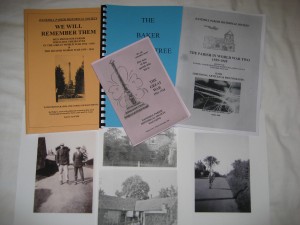 Thank you Robin for this unexpected but much treasured gift. We go outside and Johanne and Robin carry on their discussion. I have to intervene, otherwise she will never let go.
Thank you Robin for this unexpected but much treasured gift. We go outside and Johanne and Robin carry on their discussion. I have to intervene, otherwise she will never let go. 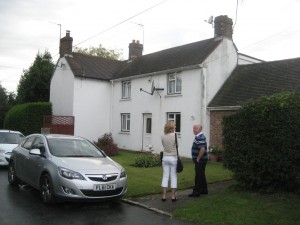 It has been a tremendous day and our minds are swimming with details.
It has been a tremendous day and our minds are swimming with details.Tomorrow we make our second attempt to go to the National Archives in Kew.
P.S. Robin, please feel free to comment and correct any errors I may have made in the above.
26 August – Our day of rest
If we have time during the week, we want to take the train to London and do a tour so this morning we make a quick trip up to East Grinstead (nearest place to catch the train) to find the train station and check out the schedules. For my day of relaxation, we had planned to visit the 1000-year-old Norman castle in nearby Lewes. Our friendly hotel proprietor Claudio suggests a trip to the seaside town of Eastbourne, the sunniest place in Great Britain, might be better suited for my day to take it easy. Off to Eastbourne we go. It’s only 30 miles south of Forest Row, piece of cake. We breeze through a series of roundabouts. Johanne calls out the exit by number (e.g. 1, 2 or 3) and I look out for the one I’m supposed to take. Everything is fine until, at one roundabout, she calls out 2, and I exit at 1. “Why did you do that?” she asks. “I did say 2.” Must have been a mental lapse. A few miles later, I turn around at the next roundabout and head back. Finally, we arrive in Eastbourne, a beautiful city by the sea somewhat reminiscent of Brighton. The view of the beach is spectacular. In the distance I can see Hastings, where the Norman conquest of England began. After walking along the boardwalk for a bit, we decide to have a bite to eat before we explore any further. We stop at a nice place off the boardwalk called The Pavillon. They’re offering Sunday Carvery (buffet) but instead we have a light lunch (Welsh Rarebit for me and Goat Cheese tartlet for Johanne).
In the distance I can see Hastings, where the Norman conquest of England began. After walking along the boardwalk for a bit, we decide to have a bite to eat before we explore any further. We stop at a nice place off the boardwalk called The Pavillon. They’re offering Sunday Carvery (buffet) but instead we have a light lunch (Welsh Rarebit for me and Goat Cheese tartlet for Johanne). 
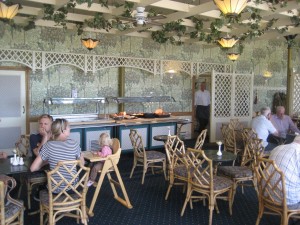 After lunch, we continue our casual stroll along the seafront enjoying the sea air and the sun.
After lunch, we continue our casual stroll along the seafront enjoying the sea air and the sun. 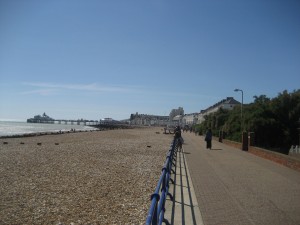
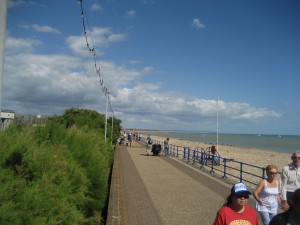
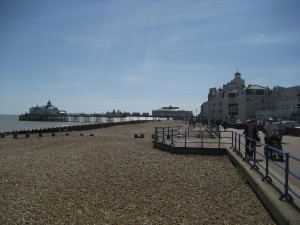
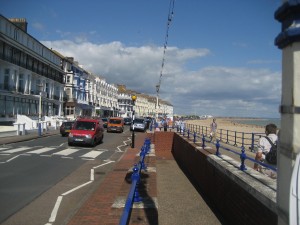
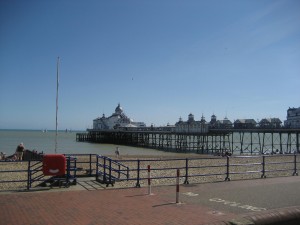 On the way back to the car, we stop at The Redoubt, a large military fortress and museum on the boardwalk that in the early 1800’s was part of a system of costal forts built to defend England against invasion by France during Napoleon’s reign.
On the way back to the car, we stop at The Redoubt, a large military fortress and museum on the boardwalk that in the early 1800’s was part of a system of costal forts built to defend England against invasion by France during Napoleon’s reign.
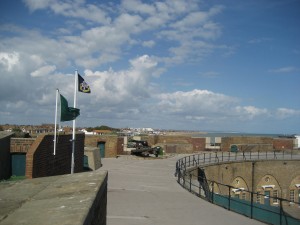
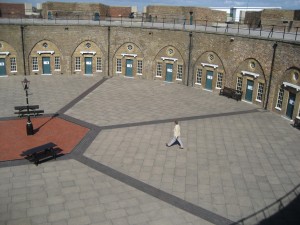
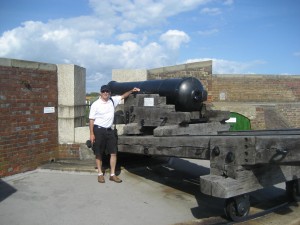 Johanne wanders out to the courtyard for some air and starts chatting with one of the workers, a member of the British Army Hussars. By chance, she finds out that Canadian troops took over the fort during WWII before they embarked on the Dieppe raid. She asks if he knows what division was here and he says, “No. But if you find any information about them, could you let us know?” Very interesting. On our day off Johanne manages to discover a military fort with a connection to Canadian soldiers. Is this all an amazing coincidence or something Johanne cooked up with Claudio for my day of relaxation?
Johanne wanders out to the courtyard for some air and starts chatting with one of the workers, a member of the British Army Hussars. By chance, she finds out that Canadian troops took over the fort during WWII before they embarked on the Dieppe raid. She asks if he knows what division was here and he says, “No. But if you find any information about them, could you let us know?” Very interesting. On our day off Johanne manages to discover a military fort with a connection to Canadian soldiers. Is this all an amazing coincidence or something Johanne cooked up with Claudio for my day of relaxation?
A few hours later, we decide it’s time to go. On the drive back, we count 22 roundabouts. That’s a total of 44. This was supposed to be a relaxing drive! Back at the Chequers, over a beer, Claudio asks how my day of rest went. “Well, we left at 10:30 am and it’s now 5:30 pm – I think I’m just beginning to relax.” I don’t share with him my conspiracy theory.
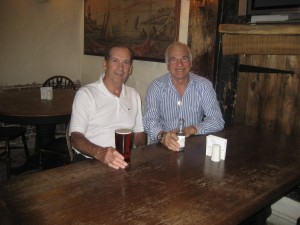
Tomorrow we go to Chelwood Gate to meet for the first time, my 4th cousin, Robin Wood. He found us because of our visit last year. Looking forward to seeing him and any other relatives.
